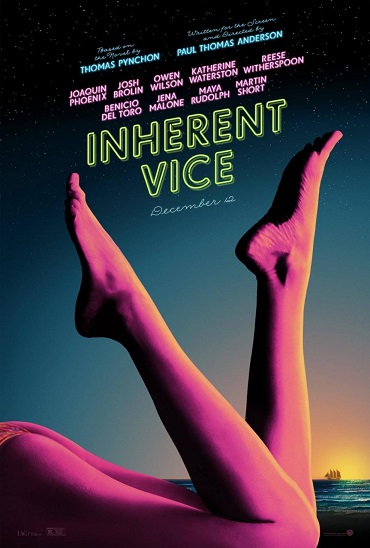Inherent Vice (2014)
Posted on January 29, 2015 by Mike Granby

Inherent Vice is like Chinatown on acid. Or more precisely, on weed with a little heroin and PCP thrown in for good luck. Paul Thomas Anderson’s adaptation of Thomas Pynchon’s novel tells the story of a private investigator’s attempt to get to the bottom of a sprawling conspiracy, not this time about water rights, but about the strange connection between a billionaire property developer and what we come to know as a vertically integrated drug cartel. Joaquin Phoenix’s hippy private eye is certainly a world away Nicholson’s Gittes, but there’s the same feeling of a protagonist who is dwarfed by matters that he’ll never quite understand, and of powerful people whose status is so far above us that nothing in the end can really touch them.
Phoenix’s performance as Larry “Doc” Sportello drives the movie. Quizzical, slightly befuddled, but always smarter or more aware than his permanently dazed look would have you believe, the timing of his facial expressions is perfect, holding each just long enough to get the effect without straying into the mugging or overacting into which a less talented performer could easily have wandered. Everything from his slouching but rhythmic gate to his perfectly chaotic hair and wardrobe serve to reinforce the distance between Doc and the strange, paranoid world around him.
The supporting cast provide able assistance. Benicio Del Toro is Sportello’s down-market attorney, whose specialty has more to do with the movie’s title than you would at first think. (Hmmm. Del Toro playing legal sidekick to spaced out main character? Fear and Loathing in Las Vegas anyone?) Reese Witherspoon is a preppy deputy DA and Doc’s current if rather intermittent love interest. Owen Wilson, whose lightness I usually find tiresome, is perfect as the eventual source of Doc's redemption. And Katherine Waterston plays Shasta Fay Hepworth, Doc’s “ex old lady” and probably the most seductive McGuffin in movie history, with her performance in one particular scene raising more than eyebrows.
But it is Josh Brolin as Lt. Det. Christian F. "Bigfoot" Bjornsen that acts as Doc’s foil and rightly receives second billing. Named, as I discovered upon reading the book and as we see later in the movie just before he and Doc share a special moment, for his preferred manner of entry, Bigfoot is uptight, aggressive and completely straight. In short, everything that Doc is not. Even though Bigfoot is a monster who specializes in “long mornings of civil rights violations”, he and Doc have an incredible chemistry, and Brolin made me warm to this flawed and slightly broken man whose life was so very far away from where he wanted it to be.
The movie’s plot is complex, to the point where a second viewing is almost obligatory. At times, it felt as if I should have had a notebook to hand, like the one into which Sportello scribbles his chaotic and fragmented asides, if only to keep track of the many wonderfully drawn—and wonderfully named—characters. There’s one point where I wondered if the studio had lost its nerve as to the audience’s ability to keep up with Anderson’s vision, adding perhaps a little too much exposition to the lilting, spaced-out voiceover provided by Joanna Newsom’s Sortilège. And the pacing seems to change about 80% of the way through, just after Waterson’s sex scene, with extra characters thrown into the mix and the resolution reached perhaps a little too quickly. Another 15 minutes or so added to the movie’s 2:28 running time would have allowed a greater opportunity to wrap things up, and even though it would then have been approaching three hours, the movie would not have felt too long.
The film’s photography is inspired, with framing, lighting and focus creating so many perfect shots that you could decorate a dozen bedrooms with prints of which you’d never grow tired. The drug addled feel of the movie is paralleled by the slight haze that washes across so many of the scenes, and by the film’s willingness to use shallow depth-of-field and sometimes a total lack of focus to blur our perceptions in line with those of our protagonist.
Especially upon second viewing, when my mind was able to spend more time watching and less time thinking, I was struck by the abject contrast between a movie like this that was actually photographed—where each scene is defined as much by what you can’t quite see or by what isn’t quite in focus—and the overwhelming, razor-sharp rendering of today’s action movies. If you walked out of a high-definition, high-framerate showing of the latest Hobbit movie with your brain blown by the unnatural amount of information thrown at you sixty times a second, you’ll walk out of this one entranced by so many memories of just how beautiful film can be.
Even if there were any other hippy noir comedy philosophical detective thrillers, Inherent Vice would top the genre.
Highly recommended. And for at least two viewings.
back